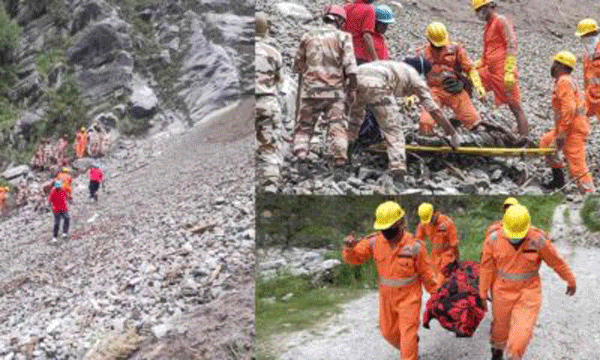by ML Verma
Shimla, Sept 5
Support Independent Journalism Complete Your Membership
Choose Your Membership
Steeply inclined slope & incessant rainfall were the geo-scientific causes behind the incidents for the Nigulsari landslide in the Kinnaur district last month. A team comprising of Geological Survey of India Northern region, Director S R Mahapatra, Geologist Atul Kohl, Assistant Geologist Vijit Thakur and Abhinav Poonia conducted the reconnaissance study on the rock slide incident of August 11 at National Highway -5 near Nigulsari village of Nichar Tehsil of Kinnuar district.
In a 12 page report prepared by the Geological Survey of India which has been submitted to the state government recently, found rainfall as a triggering factor and also steeply inclined slopes as geo scientific reason behind this catastrophic incidence.
The team of GSI visited the spot and found that incessant rainfall from the last three days before the main incidence (intimated by Gram Panchayat and local residents presents at the time of field study) were the triggering factors to cause the landslides which continued for few days. The field observation also recorded that based upon the Marcroscale Landslide Susceptibility Mapping ( NLSM) studies carried out during 2016-17, the incidence spot fall in a high susceptibility zone (Vadakkedath and Biswal 2017).
” From the field traverses also, the site appears to have been perceived as a vulnerable location to landslide hazard as the same is characterized by the presence of moderately to steeply inclined and dissected hill slopes, bottomed by steep cut slopes and further bottomed by steeper natural slopes(para-6). The rocks exposed are highly foliated and jointed with open joints at several places, ” mentioned the study.
The report further revealed that the actual slope failure incidence took place from natural slopes above the cut slopes. Voluminous debris comprising rock blocks of varying dimensions as well as soil, mostly with coarse fraction, fell in the incidence.
” Immediately after the incident of Aug 11, 2021 another incident took place on Aug 13, 2021 in which another HRTC bus had a minor escape. ”
” At the time of field observation, although water was neither observed flowing nor trickling, both from crown area and from rock slopes, wet and damp conditions were observed immediately above the crown . In all, a total of 400 meter stretch along NH-5(including the main failure zone), is characterized by the presence of highly jointed and foliated rock mass as observed along the cut slopes. ” the study elaborated.
” Based upon the photograph of electronic media and field observations of rock blocks lying close to the site of failure, it can be inferred that the size of the failed blocks could have been as large as a few cubic meters.”
”The crown of the slide is about 120 meter above the road (visual estimate) and the bottom end of the zone of depletion is above the road level. The width of the crown area is about 25 meter. The maximum depth of the depletion is about four meter in the crown part. ” pointed the study.
Report said that based upon the material and type of movement involved in the slope failure incidence, it can be classified as Rock slide ( in upper parts of the zone of depletion) and associated rock fail (in most part of the zone of depletion).
The discontinuity (joint) along which the movement occurred in the upper reaches of the zone of depletion, dips the valley at moderate to steep angle.
” The crown portion of the slide shows traces of contour parallel tension cracks, piping holes in in-situ soil, traces of rills, tilted trees, partly shaved off vegetation, exposed roots lying over the plane of sliding which might have played a role in widening of the joint planes. ”
” The density of vegetation over the rocky slopes can be at best termed as sparse, whereas in the upper reaches of the hill section, it is moderate. The spacing, continuity and mutually interfering spatial disposition of these joints have made the rock mass as assemblage of individual blocks varying in the size from few cubic cm to few cubic meters, cemented by relatively weaker links along and across the joints.”
” A rock block with some in-situ soil developed over it, was observed protruding from the valley slightly towards the left side of the crown which appears to be highly vulnerable based on field observation. In addition, several insecurely positioned blocks on cut slopes were observed .” added the study.
Preliminary inferences drawn from the end of the reconnaissance are First, Prima facie the failure appears to be a natural rock slopes failure with no signatures of anthropogenic activity seen in or adjoining areas of the crown, from where the failure was initiated as per the field observation. Second, there appears to be no preventive measures in place that are capable of reducing uncontrolled flow of water over the moderately to steeply inclined slopes or valley facing joint planes above the cut slope section. The report said that on the basis of reconnaissance, suggestions could be proved useful in minimising the slope failure incidence and risk to commuters. These suggestions need to be converted into actionable points only after adequate investigations wherever necessary, stated the group of experts in the study.
As part of suggestion based on present field investigation these geologists advised Vigil along the slope failure affected stretch as well as nearby vulnerable stretch and slope failure or landslide location along NH-5 irrespective of whether or not the preventive measures are in place . The report said that this math helps in early detection of likely failure and measures such as closure of lands likely to be affected for specific time etc. can be implemented, they added. Second they advised Identification and removal of rock blocks that are insecurely positioned and are likely to fall on the road alignment. Adding that as far as possible, blasting should be avoided for carrying out the removal of such blocks. This includes a vulnerable block ready to fall above the crown. Third, Contour parallel drain: at least two to three contour parallel drains all along the crown at appropriately identified levels to divert surface water towards nallas on either side.
Also these experts advised immediate filling of tension cracks with suitable impervious material. Adding protective measures for cut slopes these experts state that possibility of double layer shotcrete or wired mesh can be explored for the cut slopes section as several loose rock blocks are appearing that may fall at any point of time especially during the course of incessant or perennial rainfall spell.
Detailed studies, however, may be carried out for the same added this group of experts.
Further the report added that the slope preparedness is a long term process and such susceptible slopes can be identified with a fair degree of confidence through the process of landslide \susceptibility or zoning on different scales. However it must be understood that susceptibility may classify the area on as is basis and also low susceptibility does not rule out landslide occurrence, noted the report.
The study said that geomorphology of the spot is highly dissected hill and denudation of the hill slopes. The landslide and land cover is moderately vegetated. Hydrological condition is wet and damp at places in and around the crown area.
The dimension of the landslide is about 250 meter in length and 70 meter in width along the road. The height is 135 meter with a run out distance of 450 meters.
The rock type exposed in the area is Jeori-Wangtu gneiss. “The Litho units are traversed by three sets of joints that have been noticed in the area. The prima facie geo scientific cause was steeply inclined slope and incessant rainfall from the last three days before the main incident,” said the report.
The remedial measures being explored are provisions of mesh trapping and afforestation and crate wall and trock fall shelters. The report further advises that a landslide awareness programme should be launched in the form of a mission for all villages located in such fragile geo environmental condition. The rock fall incident took place on NH-5 road on August 11, 2021 in district Kinnaur.of Himachal Pradesh as per the media reported 28 death occurred and 17 injured and damage to HRTC bus and private vehicles.





